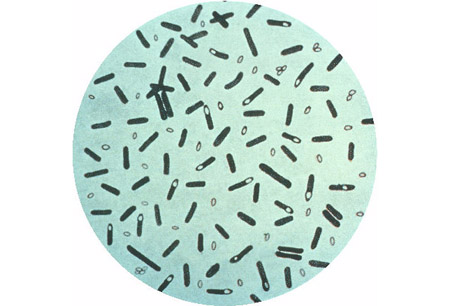Etiology
Clostridium botulinum is a large, gram-positive, strictly anaerobic bacillus that primarily exists as a spore until environmental conditions suitable for germination arise (i.e., anaerobic, pH between 4.8-8.5).[19]The species is divided into 4 genetically diverse groups that share the common ability to produce botulinum toxin.[20][21] Seven serologically distinct neurotoxins are produced by C botulinum, designated letters A through G. Human disease is attributed to toxin types A, B, E, and, less commonly, F. The toxins are zinc-dependent metalloproteinases, characterized by a heavy chain (100 kD) and a light chain (50 kD), joined by a single disulfide bond.[22][23]
C botulinum spores are found throughout the world in soil samples and marine sediments.[24] These spores are able to tolerate 212°F (100°C) at 1 atm for several hours. [Figure caption and citation for the preceding image starts]: A photomicrograph of Clostridium botulinum bacteriaCDC [Citation ends].
Pathophysiology
Clinical botulism results from the entry of botulinum toxin into the systemic circulation and subsequent inhibition of acetylcholine release from the presynaptic nerve terminal. The toxin enters the circulation through the mucosa (foodborne and inhalational) or via a break in the skin (wound and iatrogenic). In infants, absorption occurs due to absence of competing normal flora.[25] Once absorbed into the bloodstream, the toxin is carried to the synapses of peripheral and cranial nerves. The heavy chain mediates binding of the toxin to presynaptic receptors, allowing for receptor-mediated endocytosis.[26]
Acetylcholine release at the neuromuscular junction is mediated by a synaptic-fusion complex. This complex consists of 3 soluble fusion attachment protein receptors (SNARE proteins). The toxin light chain inhibits vesicle release by cleaving peptide bonds of these SNARE proteins.[27][28] Botulinum neurotoxins B, D, F, and G cleave synaptobrevin.[29][30] Toxins A, C, and E cleave synaptosomal-associated protein (SNAP)-25.[23][31] Toxin C affects syntaxin. As a result, stimulation of the presynaptic cell fails to produce transmitter release, resulting in motor paralysis or autonomic dysfunction when parasympathetic nerve terminals or autonomic ganglia are involved.
Classification
Routes of colonization
Foodborne
Ingestion of food contaminated with botulinum toxin.
Wound
Wound contamination by Clostridium botulinum spores.
Iatrogenic
Symptoms of botulism as a consequence of toxin use for cosmetic or therapeutic purposes.
Inhalational
Inhalation of aerosolized botulinum toxin; does not occur in nature and suggests an act of bioterrorism.
Infant botulism
Results from exposure in the first year of life to contaminated soil, dust, or food sources.
Use of this content is subject to our disclaimer